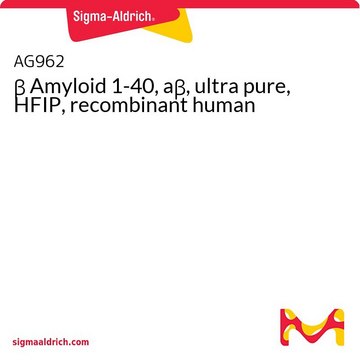ABN1665
Anti-Aβ-42 Antibody, oligomeric (VIA)
from rabbit
Sinônimo(s):
Aβ-42 oligomer, Abeta-42 oligomer, Oligomeric Aβ-42, Oligomeric Abeta-42
About This Item
Produtos recomendados
fonte biológica
rabbit
Nível de qualidade
forma do anticorpo
affinity isolated antibody
tipo de produto de anticorpo
primary antibodies
clone
polyclonal
reatividade de espécies
human
técnica(s)
dot blot: suitable
neutralization: suitable
western blot: suitable
nº de adesão UniProt
Condições de expedição
ambient
modificação pós-traducional do alvo
unmodified
Informações sobre genes
human ... APP(351)
Descrição geral
Aplicação
Neutralizing Analysis: A representative lot neutralized Aβ-42 toxicity to cultured SH-SY5Y cells (Bodani, R.U., et al. (2015). ACS Chem. Neurosci. 6(12):1981-1989).
Western Blotting Analysis: A representative lot detected oligomeric Aβ-42, but not monomeric Aβ-42, monomeric or oligomeric A -40 (Bodani, R.U., et al. (2015). ACS Chem. Neurosci. 6(12):1981-1989).
Note: Both purified antibody (Cat. No. ABN1665) and unpurified antiserum (Cat. No. ABN1650) are suitable for Dot blot, immunofluorescence, immunohistochemistry, and Western blotting applications. However, we recommend using only the purified antibody for neutralization studies.
Qualidade
Dot Blot Analysis: 6.67 µg/mL of this antibody detected recombinant Aβ-42, but not Aβ-40, oligomer.
Descrição-alvo
forma física
Outras notas
Não está encontrando o produto certo?
Experimente o nosso Ferramenta de seleção de produtos.
Código de classe de armazenamento
12 - Non Combustible Liquids
Classe de risco de água (WGK)
WGK 2
Certificados de análise (COA)
Busque Certificados de análise (COA) digitando o Número do Lote do produto. Os números de lote e remessa podem ser encontrados no rótulo de um produto após a palavra “Lot” ou “Batch”.
Já possui este produto?
Encontre a documentação dos produtos que você adquiriu recentemente na biblioteca de documentos.
Nossa equipe de cientistas tem experiência em todas as áreas de pesquisa, incluindo Life Sciences, ciência de materiais, síntese química, cromatografia, química analítica e muitas outras.
Entre em contato com a assistência técnica







![[Ala28]-Amyloid β 25-35 ≥95% (HPLC)](/deepweb/assets/sigmaaldrich/product/images/306/938/dd9f7c72-cfca-4ea3-8e10-a7a2a7994639/640/dd9f7c72-cfca-4ea3-8e10-a7a2a7994639.jpg)
